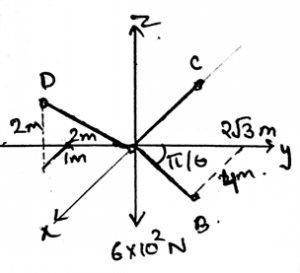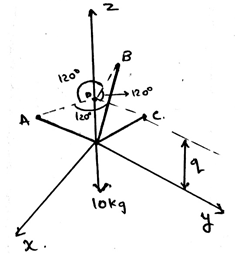This set of Advanced Engineering Mechanics Questions and Answers focuses on “Cables Subjected to its Own Weight”.
1. What is not the condition for the equilibrium in three dimensional system of axis for cable subjected to its own weight?
a) ∑Fx=0
b) ∑Fy=0
c) ∑Fz=0
d) ∑F≠0
View Answer
Explanation: For the equilibrium in the three dimensional system of axis we have all the conditions true as, ∑Fx=0, ∑Fy=0 and ∑Fz=0. Also, we have the summation of the forces equal to zero. Which is not a non-zero value.
2. The assumptions for the calculations are done for the cable subjected to its own weight. In that one of the assumption is that the cable is ___________
a) Extensible
b) Non-flexible
c) Flexible
d) Static
View Answer
Explanation: The assumptions are done so as to make the calculations easy. Though the assumptions make the small errors do not count over the big data. But still, if the assumptions are made then the calculations are easy. Thus the assumption taken as the cable is perfectly flexible.
3. The magnitude of the resultant of the two vectors in calculations for cable subjected to its own weight is always:
a) Greater than one of the vector’s magnitude
b) Smaller than one of the vector’s magnitude
c) Depends on the angle between them
d) Axis we choose to calculate the magnitude
View Answer
Explanation: Yes, the magnitude of the resultant of the two vectors always depends on the angle between them. It might be greater or smaller than one of the vector’s length. For perfectly saying, it does depend upon the angle between them.
4. In the diagram given below, coordinates of D is (1, -2, 2), C (-2, 0, 0) and B are as shown. The dark region is the cables holding the weight of 600N at origin. Find the tension in the AD section.

a) 900N
b) 693N
c) 646N
d) 0N
View Answer
Explanation: As the system is in equilibrium so we need to balance the forces. So when apply the condition of net force to be zero in the z direction, we get (2/3)FAD = 600N. This gives us force along AD be 900N.
5. Cable subjected to its own weight takes a shape of a ____________ when is subjected to loadings.
a) Helix
b) Line
c) Spring
d) Complex figure
View Answer
Explanation: The cable takes the shape of a straight line when subjected to the loadings. As the loadings are straight, acting vertically downwards, they stretch the cables and then make them come in the shape of the straight line. Thus the loadings make the cables come in the straight line.
6. The force on the cable subjected to its own weight is not neglected in the calculations of the load distribution.
a) False
b) True
View Answer
Explanation: The cable is a support system which is used to transfer the loadings in the different structures. The main motto is to make the structure stable. In calculation, the self-weight of the cable is neglected and the load is calculated. The forces are acting in the vertically downward direction.
7. Determine the value of the q, parallel to the z axis. That is the point of intersection of the projections of the points A, B and C parallel to the xy plane. With the distance between the tri-section point and the points A, B and C be equal to 0.6m.
a) 51.9cm
b) 51.9mm
c) 51.9m
d) 5.19mm
View Answer
Explanation: The application of the equilibrium equation will yield the result. That is the resultant along the z-axis will remain zero. Which give the value of γ as 50˚. And therefore q=51.9cm.
8. The assumptions for the calculations are done for the cable subjected to its own weight. In that one of the assumption is that the cable is flexible and the other is that the cable is ___________
a) Extensible
b) Non-flexible
c) Inextensible
d) Static
View Answer
Explanation: The assumptions are done so as to make the calculations easy. Though the assumptions make the small errors do not count over the big data. But still, if the assumptions are made then the calculations are easy. Thus the assumption taken as the cable is inextensible.
9. Due to which property the cable subjected to its own weight, it offers no resistance to bending?
a) Extensible property
b) Non-flexible property
c) Flexibility property
d) Static property
View Answer
Explanation: Due to the flexibility property the cable, it offers no resistance to bending. As the bending is seen in the beams and all the solid structures. Thus the bending moment produced in the cables are not affecting the cables much. Thus no affect by bending, i.e. no resistance to bending.
10. The tensile force acting on the cable subjected to its own weight is in which direction w.r.t the cable?
a) Perpendicular
b) Parallel
c) Tangential
d) At an angle of 2 radians
View Answer
Explanation: Due to the flexibility property the cable, it offers no resistance to bending. As the bending is seen in the beams and all the solid structures. Thus the bending moment produced in the cables are not affecting the cables much. So the tensile force which is being produced is acting in the tangential direction to the points of the cable along its lengths.
11. The cable weight becomes significant in the calculations of the loadings when the cable subjected to its own weight are used in the transmission lines and guys for radio antennas.
a) False
b) True
View Answer
Explanation: The cable is a support system which is used to transfer the loadings in the different structures. The main motto is to make the structure stable. But in the calculations of the loadings when the cables are used in the transmission lines and guys for antennas the self-weight of the cable is not neglected and the load is calculated.
12. The loading in the cable subjected to its own weight doesn’t change the ___________ of the cables.
a) Geometry
b) Colour
c) Bending moment
d) Point at which the shear stress is zero
View Answer
Explanation: The loading in the cables doesn’t affect the geometry of the cables. This is because of the assumptions which we have taken. The first one that the cables are perfectly elastic. And the second one that the cables are inextensible.
13. If the unknown variables in the calculations are more than the known quantities, then the number of equations required to solve all the unknown variables are for cable subjected to its own weight?
a) Infinite
b) Finite
c) Not possible
d) Question fault
View Answer
Explanation: Whatever be the calculation involved, the unknown variables will be ultimately come out from the equations. The proper use of the known quantities and the multiuse of various calculation techniques will ultimately give up the results. Thus whether it may be the case of the cables or the beams the equations if applied properly will result in the determination of the unknowns.
14. For calculations involved for cable subjected to its own weight all the vectors quantities obey :
a) Parallelogram law of addition
b) Parallelogram law of multiplication
c) Parallelogram law of addition of square root of their magnitudes
d) Parallelogram law of addition of square of their magnitudes
View Answer
Explanation: All the vectors quantities obey parallelogram law of addition. Two vectors A and B (can be called as component vectors) are added to form a resultant vector. R = A+B.
15. If two equal vector forces are mutually perpendicular in the cable subjected to its own weight then the resultant force is acting at which angle as compared to one of the vector?
a) 45 degree
b) 90 degree
c) 180 degree
d) 0 degree
View Answer
Explanation: The vectors are mutually perpendicular, this means that the angle between the forces is 90 degree. Thus the resultant will form at 45 degrees to any of the vector.
Sanfoundry Global Education & Learning Series – Engineering Mechanics.
To practice advanced questions and answers on all areas of Engineering Mechanics, here is complete set of 1000+ Multiple Choice Questions and Answers.
If you find a mistake in question / option / answer, kindly take a screenshot and email to [email protected]

